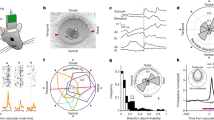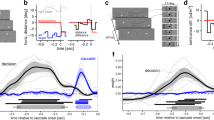Abstract
Behaviour often depends on the ability to make categorical judgements about sensory information acquired over time. Such judgements require a comparison of the evidence favouring the alternatives1,2,3,4, but how the brain forms these comparisons is unknown. Here we show that in a visual discrimination task, the accumulating balance of sensory evidence favouring one interpretation over another is evident in the neural circuits that generate the behavioural response. We trained monkeys to make a direction judgement about dynamic random-dot motion5 and to indicate their judgement with an eye movement to a visual target. We interrupted motion viewing with electrical microstimulation of the frontal eye field and analysed the resulting, evoked eye movements for evidence of ongoing activity associated with the oculomotor response6,7,8,9,10. Evoked eye movements deviated in the direction of the monkey's judgement. The magnitude of the deviation depended on motion strength and viewing time. The oculomotor signals responsible for these deviations reflected the accumulated motion information that informed the monkey's choices on the discrimination task. Thus, for this task, decision formation and motor preparation appear to share a common level of neural organization.
This is a preview of subscription content, access via your institution
Access options
Subscribe to this journal
Receive 51 print issues and online access
$199.00 per year
only $3.90 per issue
Buy this article
- Purchase on Springer Link
- Instant access to full article PDF
Prices may be subject to local taxes which are calculated during checkout





Similar content being viewed by others
References
Graham, N. V. S. Visual Pattern Analyzers (Oxford Univ. Press, Oxford, 1989).
Carpenter, R. H. & Williams, M. L. Neural computation of log likelihood in control of saccadic eye movements. Nature 377, 59–62 ( 1995).
Leon, M. I. & Shadlen, M. N. Exploring the neurophysiology of decisions. Neuron 21, 669– 672 (1998).
Schall, J. D. & Thompson, K. G. Neural selection and control of visually guided eye movements. Annu. Rev. Neurosci. 22, 241–259 (1999).
Britten, K. H., Shadlen, M. N., Newsome, W. T. & Movshon, J. A. The analysis of visual motion: a comparison of neuronal and psychophysical performance. J. Neurosci. 12, 4745– 4765 (1992).
Schlag-Rey, M., Schlag, J. & Shook, B. Interactions between natural and elecrically evoked saccades. I. Differences between sites carrying retinal error and motor error signals in monkey superior colliculus. Exp. Brain Res. 76, 537–547 (1989).
Kustov, A. A. & Robinson, D. L. Shared neural control of attentional shifts and eye movements. Nature 384, 74 –77 (1996).
Sparks, D. L. & Mays, L. E. Spatial localization of saccade targets. I. Compensation for stimulation-induced perturbations in eye position. J. Neurophysiol. 49, 45– 63 (1983).
Sparks, D. L., Mays, L. E. & Porter, J. D. Eye movements induced by pontine stimulation: interaction with visually triggered saccades. J. Neurophysiol. 58, 300–318 (1987).
Tehovnik, E. J., Slocum, W. M. & Schiller, P. H. Behavioural conditions affecting saccadic eye movements elicited electrically from the frontal lobes of primates. Eur. J. Neurosci. 11, 2431–2443 (1999).
Shadlen, M. N., Britten, K. H., Newsome, W. T. & Movshon, J. A. A computational analysis of the relationship between neuronal and behavioral responses to visual motion. J. Neurosci. 16, 1486–1510 (1996).
Bruce, C. J. & Goldberg, M. E. Primate frontal eye fields. I. Single neurons discharging before saccades. J. Neurophysiol. 53, 603–635 ( 1985).
Wurtz, R. H. & Goldberg, M. E. Activity of superior colliculus in behaving monkey. III. Cells discharging before eye movements. J. Neurophysiol. 35, 575–586 (1972).
Mays, L. E. & Sparks, D. L. Dissociation of visual and saccade-related responses in superior colliculus neurons. J. Neurophysiol. 43, 207–232 (1980).
Schiller, P. H. & Sandell, J. H. Interactions between visually and electrically elicited saccades before and after superior colliculus and frontal eye field ablations in the rhesus monkey. Exp. Brain Res. 49, 381–392 (1983).
Lee, C., Rohrer, W. H. & Sparks, D. L. Population coding of saccadic eye movements by neurons in the superior colliculus. Nature 332, 357–360 (1988).
Sparks, D. L., Lee, C. & Rohrer, W. H. Population coding of the direction, amplitude, and velocity of saccadic eye movements by neurons in the superior colliculus. Cold Spring Harb. Symp. Quant. Biol. 55, 805– 811 (1990).
Geisler, W. S. & Albrecht, D. G. Visual cortex neurons in monkeys and cats: detection, discrimination, and identification. Vis. Neurosci. 14, 897– 919 (1997).
Shadlen, M. N. & Newsome, W. T. The variable discharge of cortical neurons: implications for connectivity, computation, and information coding. J. Neurosci. 18, 3870–3896 (1998).
Britten, K. H., Shadlen, M. N., Newsome, W. T. & Movshon, J. A. Responses of neurons in macaque MT to stochastic motion signals. Vis. Neurosci. 10, 1157–1169 (1993).
Robinson, D. A. Integrating with neurons. Annu. Rev. Neurosci. 12, 33–45 (1989).
Green, D. M. & Swets, J. A. Signal Detection Theory and Psychophysics (Wiley, New York, 1966).
Platt, M. L. & Glimcher, P. W. Neural correlates of decision variables in parietal cortex. Nature 400, 233–238 (1999).
Horwitz, G. D. & Newsome, W. T. Separate signals for target selection and movement specification in the superior colliculus. Science 284, 1158–1161 (1999).
Shadlen, M. N. & Newsome, W. T. Motion perception: seeing and deciding. Proc. Natl Acad. Sci. USA 93, 628–633 (1996).
Kim, J.-N. & Shadlen, M. N. Neural correlates of a decision in the dorsolateral prefrontal cortex of the macaque. Nature Neurosci. 2, 176–185 ( 1999).
Bruce, C. J., Goldberg, M. E., Bushnell, M. C. & Stanton, G. B. Primate frontal eye fields. II. Physiological and anatomical correlates of electrically evoked eye movements. J. Neurophysiol. 54, 714–734 (1985).
Robinson, D. A. A method of measuring eye movement using a scleral search coil in a magnetic field. IEEE Trans. Biomed. Eng. 10, 137– 145 (1963).
Judge, S. J., Richmond, B. J. & Chu, F. C. Implantation of magnetic search coils for measurement of eye position: an improved method. Vision Res. 20 , 535–538 (1980).
Zohary, E., Shadlen, M. N. & Newsome, W. T. Correlated neuronal discharge rate and its implications for psychophysical performance. Nature 370, 140–143 (1994).
Acknowledgements
We thank M. Mihali for animal training and technical support, and E. Freedman, G. Horwitz, B. Jagadeesh, T. Movshon and F. Rieke for helpful comments on the manuscript. This work was supported by the NEI, NCRR and the McKnight Foundation.
Author information
Authors and Affiliations
Corresponding author
Rights and permissions
About this article
Cite this article
Gold, J., Shadlen, M. Representation of a perceptual decision in developing oculomotor commands . Nature 404, 390–394 (2000). https://doi.org/10.1038/35006062
Received:
Accepted:
Issue Date:
DOI: https://doi.org/10.1038/35006062
This article is cited by
-
Working memory performance is tied to stimulus complexity
Communications Biology (2023)
-
Neural cognitive signals during spontaneous movements in the macaque
Nature Neuroscience (2023)
-
Value dynamics affect choice preparation during decision-making
Nature Neuroscience (2023)
-
Explicit effort may not influence perceptuomotor decision-making
Experimental Brain Research (2023)
-
Perceptual decisions and oculomotor responses rely on temporally distinct streams of evidence
Communications Biology (2022)
Comments
By submitting a comment you agree to abide by our Terms and Community Guidelines. If you find something abusive or that does not comply with our terms or guidelines please flag it as inappropriate.



